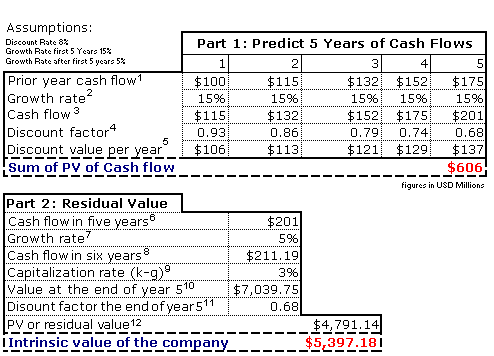The idea of discounting cash flows seems okay in theory, but implementing it in real life is difficult. One of the most obvious challenges is determining how far into the future we should forecast cash flows. It's hard enough to predict next year's profits, so how can we predict the course of the next 10 years? What if a company goes out of business? What if a company survives for hundreds of years?
All of these uncertainties and possibilities explain why there are many different models devised for discounting cash flows, but none completely escapes the complications posed by the uncertainty of the future.
[ Discounted cash flow analysis is one of the most popular ways to assess a company's intrinsic valuation. By discounting future cash flows to a present value, investors can see how much a company is worth given its expected growth over the coming years. Investopedia's Fundamental Analysis Course provides a comprehensive introduction to all types of fundamental analysis in over five hours of on-demand video, exercises, and interactive content. You'll learn how to identify companies that are undervalued and capitalize on their prices. ]
Putting the Discounted Cash Flow Theory into Practice
Let's look at a sample of a model used to value a company. Because this is a generalized example, don't worry if some details aren't clear. The purpose is to demonstrate the bridging between theory and application. Take a look at how valuation based on fundamentals would look:
 |
The problem with projecting far into the future is that we have to account for the different rates at which a company will grow as it enters different phases. To get around this problem, this model has two parts: (1) determining the sum of the discounted future cash flows from each of the next five years (years one to five), and (2) determining 'residual value,' which is the sum of the future cash flows from the years starting six years from now.
In this particular example, the company is assumed to grow at 15% a year for the first five years and then 5% every year after that (year six and beyond). First, we add together all the first five yearly cash flows – each of which is discounted to year zero, the present – in order to determine the present value (PV).
Once the present value of the company for the first five years is calculated, we must, in the second stage of the model, determine the value of the cash flows coming from the sixth year and all the following years, when the company's growth rate is assumed to be 5%. The cash flows from all these years are discounted back to year five and added together, then discounted to year zero, and finally combined with the PV of the cash flows from years one to five (which we calculated in the first part of the model). And voilà! We have an estimate (given our assumptions) of the intrinsic value of the company.
Understanding the Details
An estimate that is higher than the current market capitalization indicates that it may be a good buy. Below, we have gone through each component of the model with specific notes:
- Prior-year cash flow – The theoretical amount, or total profits, that the shareholders could take from the company the previous year.
- Growth rate – The rate at which owner's earnings are expected to grow for the next five years.
- Cash flow – The theoretical amount that shareholders would get if all the company's earnings, or profits, were distributed to them.
- Discount factor – The number that brings the future cash flows back to year zero. In other words, the factor used to determine the cash flows' present value (PV).
- Discount per year – The cash flow multiplied by the discount factor.
- Cash flow in year five – The amount the company could distribute to shareholders in year five.
- Growth rate – The growth rate from year six into perpetuity.
- Cash flow in year six – The amount available in year six to distribute to shareholders.
- Capitalization Rate – The discount rate (the denominator) in the formula for a constantly growing perpetuity.
- Value at the end of year five – The value of the company in five years.
- Discount factor at the end of year five – The discount factor that converts the value of the firm in year five into the present value.
- PV of residual value – The present value of the firm in year five.
So far, we've been very general on what a cash flow comprises, and unfortunately, there is no easy way to measure it. The only natural cash flow from a public company to its shareholders is a dividend, and the dividend discount model (DDM) values a company based on its future dividends (see Digging into the DDM.). However, a company doesn't pay out all of its profits in dividends, and many profitable companies don't pay dividends at all.
What happens in these situations? Other valuation options include analyzing net income, free cash flow, EBITDA and a series of other financial measures. There are advantages and disadvantages to using any of these metrics to get a glimpse into a company's intrinsic value. The point is that what represents cash flow depends on the situation. Regardless of which model is used, the theory behind all of them is the same.
Stock-Picking Strategies: Qualitative Analysis
-
 Investing
InvestingEvaluating A Statement Of Cash Flows
The metrics for the Statement of Cash Flows is best viewed over time. -
 Investing
InvestingFundamental Case Study: Is Amazon's Cash Flow Actually Solid? (AMZN)
Review Amazon's cash flow situation, including its free cash flow yield, operating cash flow from organic growth and cash flow from debt financing. -
 Investing
InvestingTop 3 Pitfalls Of Discounted Cash Flow Analysis
Find out why the Discounted Cash Flow (DCF) method can be difficult to apply to real-life valuations. -
 Investing
InvestingDigging Into the Dividend Discount Model
The DDM is one of the most foundational financial theories, but it's only as good as its assumptions. Learn if this model works for you and how to use it. -
 Investing
InvestingThe Importance of Properly Managing Your Cash Flow
The more cash you have, the more cash flow you can create which builds wealth. -
 Financial Advisor
Financial AdvisorA Guide on the Risk-Adjusted Discount Rate
When a project or investment faces higher amounts of risk or uncertainty, it may be appropriate to utilize the risk-adjusted discount rate. -
 Investing
Investing5 Companies With Huge Cash Flow
If history continues to repeat itself, these five companies have major cash flow which makes them good long-term bets.



